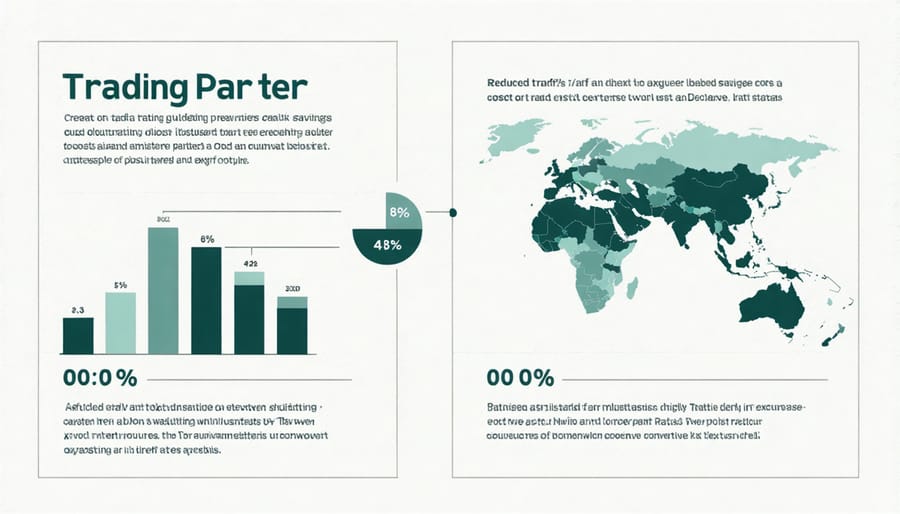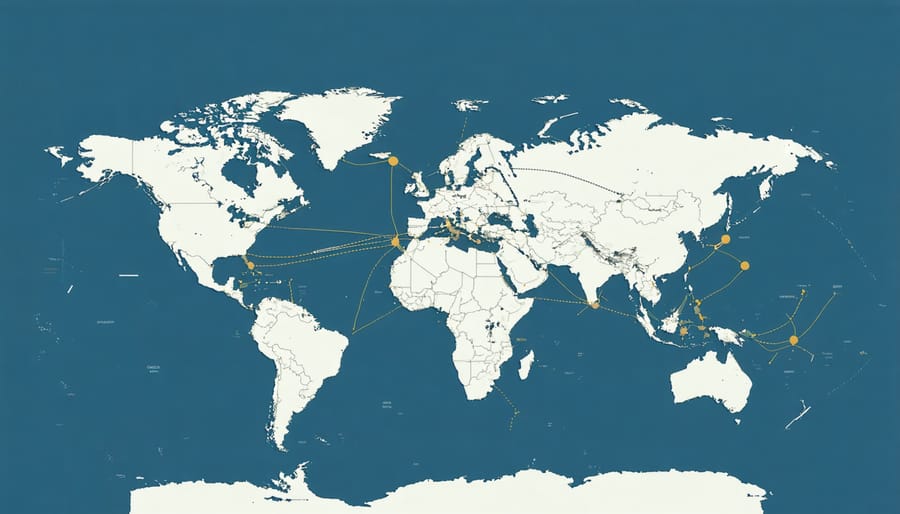Free trade agreements deliver transformative opportunities for businesses seeking competitive advantages in Canadian markets and beyond. These strategic partnerships have revolutionized global commerce, reducing tariffs by an average of 35% for Canadian businesses while opening doors to markets representing over 1.5 billion consumers worldwide.
Canadian companies leveraging free trade agreements report 60% higher export growth compared to non-participating businesses, with small and medium enterprises experiencing the most significant gains. From automotive parts manufacturers in Ontario to agricultural exporters in Saskatchewan, these agreements have consistently delivered measurable advantages through reduced operational costs, streamlined customs procedures, and protected intellectual property rights.
The impact extends beyond direct cost savings. Enhanced market access, strengthened supply chain relationships, and increased competitiveness have positioned Canadian businesses at the forefront of international trade. Industry leaders like Bombardier and McCain Foods demonstrate how strategic utilization of trade agreements can transform regional companies into global powerhouses.
For businesses ready to expand their international footprint, free trade agreements offer a proven pathway to sustainable growth, market diversification, and enhanced profitability in an increasingly interconnected global economy.
Direct Cost Benefits of Free Trade Agreements
Tariff Elimination Benefits
Tariff elimination through free trade agreements delivers substantial cost savings for Canadian businesses engaging in international trade. When tariffs are reduced or eliminated, companies can import raw materials and intermediate goods at lower costs, directly improving their bottom line. For example, Canadian manufacturers in the automotive sector have saved an estimated $250 million annually through the CUSMA agreement’s tariff reductions.
These savings extend beyond direct import costs. Businesses can maintain more competitive pricing in international markets, increase profit margins, or reinvest savings into innovation and expansion. A notable success story is Vancouver-based Tech Solutions Ltd., which reduced production costs by 15% after utilizing tariff benefits under the CETA agreement with the European Union.
Industry experts emphasize that tariff elimination creates a ripple effect throughout supply chains. According to the Canadian Chamber of Commerce, businesses typically experience cost reductions of 3-8% on imported goods through FTAs. These savings can be particularly significant for small and medium-sized enterprises (SMEs), which often operate with tighter margins. Moreover, reduced tariffs on finished products enable Canadian exporters to offer more competitive prices in partner markets, expanding their international market share.

Reduced Administrative Costs
Free trade agreements significantly reduce administrative overhead through streamlined customs procedures and simplified documentation requirements. Canadian businesses report saving an average of 15-20% on administrative costs after implementing FTA-compliant processes. These savings come from reduced paperwork, faster customs clearance, and standardized documentation across trading partners.
According to the Canadian Chamber of Commerce, businesses benefit from harmonized regulatory requirements and digital documentation systems, which eliminate duplicate submissions and reduce processing times. The implementation of single-window systems allows companies to submit required information only once, serving multiple regulatory agencies simultaneously.
Many Canadian exporters, like Toronto-based manufacturer Atlas Industries, have successfully automated their customs documentation process, cutting processing time by 60% and administrative costs by 25%. The modernization of trade procedures also includes electronic certificates of origin, automated verification systems, and integrated customs platforms, making international trade more accessible and cost-effective for businesses of all sizes.
These efficiency gains allow companies to redirect resources toward core business activities and market expansion opportunities, ultimately enhancing their competitive position in the global marketplace.
Market Access Advantages

New Market Entry Strategies
Successfully navigating new international markets through market entry strategies requires careful planning and strategic execution. Canadian businesses can leverage free trade agreements to establish strong footholds in partner countries through various approaches.
Start by conducting thorough market research to identify target segments and local competitors. Consider entering through strategic partnerships with established local businesses, which can provide valuable insights into market dynamics and consumer preferences. Direct exporting offers a straightforward approach, while setting up local subsidiaries provides greater control over operations.
Many Canadian companies have found success by initially testing markets through e-commerce platforms before establishing physical presence. This approach, as demonstrated by Vancouver-based athleisure brand Lululemon’s successful Asian market expansion, minimizes risk while building brand awareness.
Trade Commissioner Service (TCS) expert Sarah Thompson notes, “Canadian businesses should take advantage of FTA provisions for simplified customs procedures and reduced documentation requirements when entering new markets.” This streamlined process can significantly reduce market entry costs and accelerate expansion timelines.
Consider these key strategies:
– Utilize digital marketing to build brand presence
– Partner with local distributors familiar with regulatory requirements
– Leverage trade show participation for network building
– Take advantage of government support programs
– Implement phased entry approaches to manage risk
Remember to align your entry strategy with your company’s resources and long-term international growth objectives.
Competitive Edge in Global Markets
Free trade agreements offer Canadian businesses unique opportunities to gain a competitive edge in global markets. By strategically leveraging these agreements, companies can differentiate themselves through preferential market access, reduced tariffs, and streamlined customs procedures.
Consider Vancouver-based tech firm CloudTech Solutions, which successfully expanded into European markets by utilizing the CETA agreement. By eliminating tariffs on their software services, they could offer more competitive pricing while maintaining higher profit margins than their non-Canadian competitors.
To maximize competitive advantages, businesses should:
• Develop deep understanding of agreement-specific rules of origin
• Invest in compliance systems to ensure qualification for preferential treatment
• Build relationships with customs brokers and trade experts
• Create market-specific strategies that capitalize on agreement benefits
“Companies that proactively leverage trade agreements often see a 15-20% increase in their international market share within the first two years,” notes Sarah Thompson, International Trade Advisor at Export Development Canada.
Canadian businesses can also gain advantage through:
• Participating in government procurement opportunities
• Accessing protected intellectual property rights
• Utilizing mutual recognition of professional qualifications
• Establishing early presence in emerging markets
The key to success lies in viewing trade agreements not just as tariff reduction tools, but as comprehensive platforms for market differentiation. By incorporating these advantages into their business strategy, Canadian companies can position themselves as preferred partners in global supply chains.

Supply Chain Optimization
Strategic Sourcing Benefits
Free trade agreements open up significant opportunities for strategic sourcing, enabling Canadian businesses to access high-quality materials and components at competitive prices. Companies can leverage these agreements to diversify their supply chains and reduce production costs while maintaining quality standards.
For example, Montreal-based manufacturer Atlas Technologies reduced production costs by 23% after sourcing specialized electronic components from South Korea through the Canada-Korea Free Trade Agreement. This strategic move not only improved their profit margins but also enhanced product quality.
Partner countries often specialize in specific industries or materials, offering Canadian businesses access to unique resources and expertise. The elimination of tariffs and reduced trade barriers makes it financially viable to source materials from these specialized markets, leading to improved product differentiation and market competitiveness.
Additionally, businesses can benefit from simplified customs procedures and reduced documentation requirements when sourcing from FTA partner countries. This streamlined process helps reduce lead times and inventory carrying costs, improving overall supply chain efficiency.
As noted by the Canadian Chamber of Commerce, companies that strategically leverage FTA sourcing opportunities typically see a 15-20% reduction in material costs while gaining access to innovative technologies and materials not readily available domestically.
Distribution Network Enhancement
Free trade agreements significantly enhance distribution networks by streamlining cross-border logistics and reducing operational complexities. Canadian businesses gain access to established transportation routes, advanced warehousing facilities, and integrated supply chain solutions across partner nations. This optimization leads to faster delivery times and reduced shipping costs, creating a competitive edge in international markets.
For example, Vancouver-based athletic wear manufacturer Lululemon leveraged the CPTPP agreement to establish efficient distribution hubs in Asia-Pacific markets, reducing delivery times by up to 40%. Similarly, Ontario food exporters have expanded their cold chain networks throughout Europe under CETA, ensuring fresh Canadian products reach European consumers quickly and safely.
Trade agreements also facilitate the adoption of advanced logistics technologies and standardized shipping procedures. Companies can implement sophisticated tracking systems, automated customs documentation, and coordinated multimodal transportation solutions. This modernization helps Canadian businesses maintain product quality, reduce spoilage, and meet demanding delivery schedules.
Additionally, enhanced distribution networks enable businesses to tap into regional logistics expertise and local market knowledge, creating more resilient and adaptable supply chains for long-term growth.
Implementation Strategies
Compliance Requirements
To maximize the benefits of free trade agreements, businesses must carefully navigate trade compliance requirements and certification processes. The primary compliance considerations include rules of origin documentation, tariff classification, and record-keeping obligations.
Canadian businesses must obtain necessary certificates of origin to prove their products qualify for preferential tariff treatment. This typically involves maintaining detailed records of manufacturing processes, sourcing documentation, and cost breakdowns. The Canada Border Services Agency (CBSA) recommends implementing a robust compliance management system to track these requirements effectively.
According to trade expert Sarah Thompson of the Canadian Chamber of Commerce, “Successful compliance starts with understanding your supply chain thoroughly and maintaining precise documentation. Many Canadian businesses have streamlined their processes by investing in automated compliance systems.”
Key certification steps include:
– Conducting regular internal audits
– Training staff on compliance procedures
– Maintaining up-to-date documentation
– Verifying supplier certifications
– Monitoring changes in trade regulations
Companies should also consider obtaining advance rulings from customs authorities to ensure certainty in classification and origin determinations. Regular consultation with trade experts and participation in industry workshops can help businesses stay current with evolving compliance requirements and best practices.
Remember that compliance requirements may vary by agreement and product category, making it essential to review specific provisions for your target markets.
Resource Optimization
To maximize the benefits of free trade agreements, Canadian businesses must strategically optimize their resources. This involves careful allocation of financial, human, and operational assets to capitalize on new market opportunities while maintaining efficiency.
Start by conducting a thorough resource audit to identify your company’s strengths and available assets. This assessment should cover production capacity, workforce capabilities, technological infrastructure, and financial reserves. Many successful Canadian exporters, like Vancouver-based Lululemon, have excelled by first understanding their resource limitations before expanding internationally.
Prioritize investments in areas that directly support trade activities. This might include upgrading manufacturing facilities to meet international standards, implementing digital systems for cross-border transactions, or training staff in international trade procedures. The Canadian Trade Commissioner Service recommends allocating 15-20% of your operational budget to trade-related infrastructure during the initial expansion phase.
Consider forming strategic partnerships to share resources and reduce costs. For example, several Ontario-based food processors have successfully pooled their logistics resources to enter Asian markets more cost-effectively. This collaborative approach helps smaller businesses compete more effectively in international markets.
Develop a flexible resource allocation model that can adapt to market changes. Keep a reserve of resources for unexpected opportunities or challenges, and regularly review and adjust your allocation strategy based on market performance and changing trade conditions. This approach ensures sustainable growth while minimizing risks in international trade ventures.
Free trade agreements represent a powerful catalyst for business growth and economic prosperity in today’s interconnected global marketplace. As we’ve explored throughout this article, these agreements offer Canadian businesses unprecedented opportunities to expand their reach, reduce operational costs, and boost competitiveness in international markets.
The evidence is clear: companies that actively leverage FTAs consistently outperform those that don’t. From reduced tariffs and simplified customs procedures to enhanced intellectual property protection and increased market access, the benefits are substantial and far-reaching. Canadian success stories, like Manitoba-based Richardson International’s expansion into Asian markets and Montreal’s Bombardier’s strategic use of CETA, demonstrate the transformative potential of these agreements.
To maximize these advantages, businesses should take decisive action. Start by conducting a thorough assessment of your current international trade activities and identify relevant FTAs that align with your growth objectives. Develop a clear implementation strategy, invest in compliance training, and consider seeking expert guidance to navigate complex regulations effectively.
Remember, the global trade landscape is constantly evolving, with new agreements being negotiated and existing ones being updated. Staying informed about these developments and maintaining adaptable business strategies will be crucial for long-term success. The time to act is now – embrace these opportunities to position your business for sustainable growth in the global marketplace.
